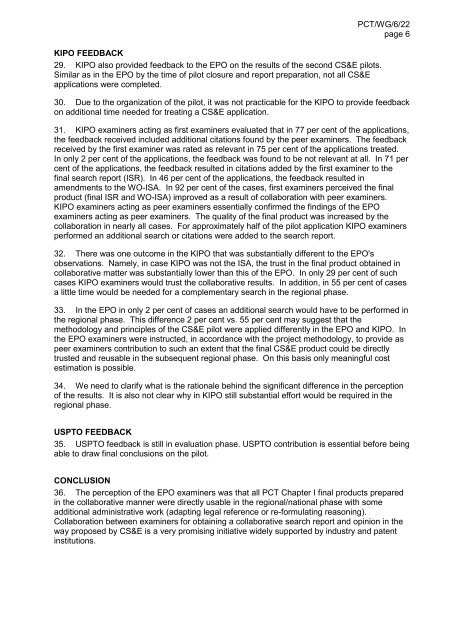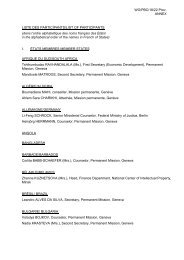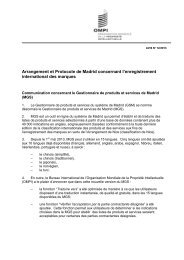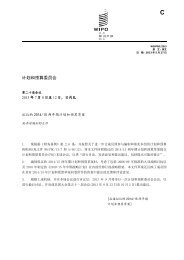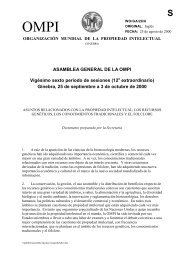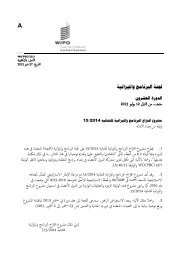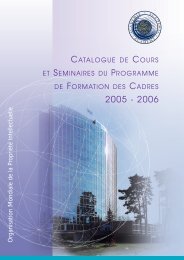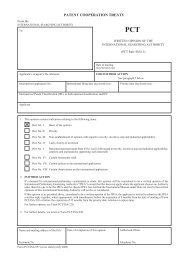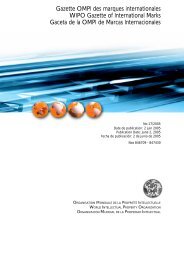Patent Cooperation Treaty (PCT) Working Group - WIPO
Patent Cooperation Treaty (PCT) Working Group - WIPO
Patent Cooperation Treaty (PCT) Working Group - WIPO
You also want an ePaper? Increase the reach of your titles
YUMPU automatically turns print PDFs into web optimized ePapers that Google loves.
KIPO FEEDBACK29. KIPO also provided feedback to the EPO on the results of the second CS&E pilots.Similar as in the EPO by the time of pilot closure and report preparation, not all CS&Eapplications were completed.<strong>PCT</strong>/WG/6/22page 630. Due to the organization of the pilot, it was not practicable for the KIPO to provide feedbackon additional time needed for treating a CS&E application.31. KIPO examiners acting as first examiners evaluated that in 77 per cent of the applications,the feedback received included additional citations found by the peer examiners. The feedbackreceived by the first examiner was rated as relevant in 75 per cent of the applications treated.In only 2 per cent of the applications, the feedback was found to be not relevant at all. In 71 percent of the applications, the feedback resulted in citations added by the first examiner to thefinal search report (ISR). In 46 per cent of the applications, the feedback resulted inamendments to the WO-ISA. In 92 per cent of the cases, first examiners perceived the finalproduct (final ISR and WO-ISA) improved as a result of collaboration with peer examiners.KIPO examiners acting as peer examiners essentially confirmed the findings of the EPOexaminers acting as peer examiners. The quality of the final product was increased by thecollaboration in nearly all cases. For approximately half of the pilot application KIPO examinersperformed an additional search or citations were added to the search report.32. There was one outcome in the KIPO that was substantially different to the EPO'sobservations. Namely, in case KIPO was not the ISA, the trust in the final product obtained incollaborative matter was substantially lower than this of the EPO. In only 29 per cent of suchcases KIPO examiners would trust the collaborative results. In addition, in 55 per cent of casesa little time would be needed for a complementary search in the regional phase.33. In the EPO in only 2 per cent of cases an additional search would have to be performed inthe regional phase. This difference 2 per cent vs. 55 per cent may suggest that themethodology and principles of the CS&E pilot were applied differently in the EPO and KIPO. Inthe EPO examiners were instructed, in accordance with the project methodology, to provide aspeer examiners contribution to such an extent that the final CS&E product could be directlytrusted and reusable in the subsequent regional phase. On this basis only meaningful costestimation is possible.34. We need to clarify what is the rationale behind the significant difference in the perceptionof the results. It is also not clear why in KIPO still substantial effort would be required in theregional phase.USPTO FEEDBACK35. USPTO feedback is still in evaluation phase. USPTO contribution is essential before beingable to draw final conclusions on the pilot.CONCLUSION36. The perception of the EPO examiners was that all <strong>PCT</strong> Chapter I final products preparedin the collaborative manner were directly usable in the regional/national phase with someadditional administrative work (adapting legal reference or re-formulating reasoning).Collaboration between examiners for obtaining a collaborative search report and opinion in theway proposed by CS&E is a very promising initiative widely supported by industry and patentinstitutions.


